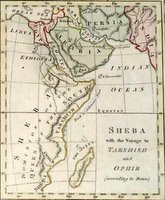 Following a good comment from K-dreaming about the History of the fork, I have searched about History of chopsticks.
Following a good comment from K-dreaming about the History of the fork, I have searched about History of chopsticks.It is commonly admitted that chopsticks appeared in China around 5000 years ago. Before that date, food was taken from big pots in the fire pricked in long sticks directly cut from trees. Later on, with the increasing population, fuel resources became scarce. This slowly lead to a new way of cooking that required less wood, for which food was cut in small pieces so that it took less time to cook. Then food could be eaten directly from the pot, eliminating the need of knives, and tree branches gradually became chopsticks.
Although the most ancient existing pair of chopsticks dates from the Tang dynasty (7th-10th centuries), it is written in the Liji (Book of Rites) that
 chopsticks were used already during the Shang dynasty (16th-12th centuries BC). Sima Qian stated in his History book, that the last king of the dynasty used ivory chopsticks. According to experts, bamboo and wooden chopsticks should date at least from 1000 years earlier. In the following centuries, bronze, golden and silver chopsticks became fashionable. Specially the latter were popular among aristocracy, as it was thought that silver became black when it was in contact with poison. This belief is exaggerated (actually silver does not react to arsenic neither to cyanide), but there is something true: rotten eggs, onions and garlic expell hydrogen sulphyde, which does change the colour of silver.
chopsticks were used already during the Shang dynasty (16th-12th centuries BC). Sima Qian stated in his History book, that the last king of the dynasty used ivory chopsticks. According to experts, bamboo and wooden chopsticks should date at least from 1000 years earlier. In the following centuries, bronze, golden and silver chopsticks became fashionable. Specially the latter were popular among aristocracy, as it was thought that silver became black when it was in contact with poison. This belief is exaggerated (actually silver does not react to arsenic neither to cyanide), but there is something true: rotten eggs, onions and garlic expell hydrogen sulphyde, which does change the colour of silver.Probably, Confucius' teachings contributed to promote the use of chopsticks at the table. He said, literally: "the honorable and correct man is well aware of the differences between slaughterhouse and table. And does not allow the use of knives at his table." Because of Confucius' popularity, who was by
 the way a vegetarian, this sentence eliminated the Western habit to use knives at the table.
the way a vegetarian, this sentence eliminated the Western habit to use knives at the table.Around the 6th century, the use of chopsticks spread to other countries such as Korea, Vietnam and Japan. Although in Japan it was first used only for religious ceremonies, it soon acquired culinary popularity, and the Japanese even created a new kind of chopsticks typical of their country: with a more sharpened point than Chinese ones, and attached at the base. From the 10th century this attachment disappeared and the became the Japanese chopsticks we know nowadays. They were also spread in Thailand, but in the 19th century the king Rama V introduced Western table utensils, limiting the use of chopsticks only to noodles.
Tools similar to chopsticks were found in the archeological findings in Meggido (Israel), belonging to Scythian invaders of Canaan, and contemporary of Moses and Josuah. This discovery reveals the extension of trade between Middle East and Far East in ancient times. Chopsticks were also common tools used by the Uyghurs in the steppes of Mongolia during the 6th-8th centuries.










